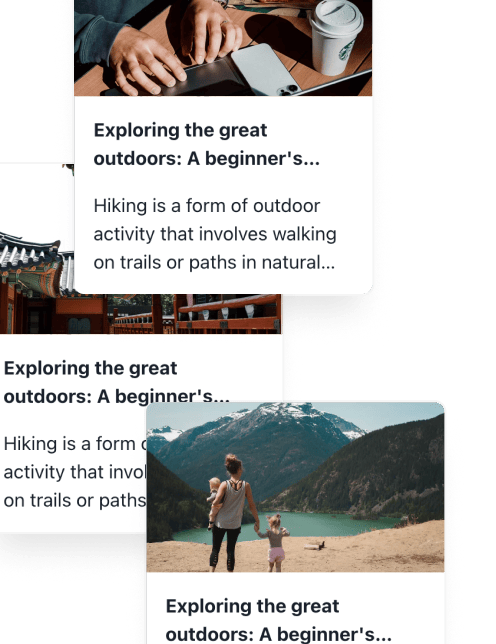5 Reasons to Use AI for Creating Content Briefs

Content scaling can be a daunting task. You write one piece of content, then it’s time to write another, only to discover that the second article is supposed to be about a subtopic of the first. Before you know it, you’re in the weeds, and the original goal of your content project is nowhere to be found. A well-crafted SEO brief could have helped you get organized and stay focused. But creating those briefs can be a challenge, too, especially if you're trying to do it manually. That’s where AI content briefs come in.
This guide will cover five reasons to use AI for creating content briefs so you can keep your content project on track. Arvo’s AI article writer for SEO can help you achieve your content goals faster and with less stress. Its AI content brief tool quickly generates detailed SEO briefs to help you create high-quality, optimized content. Let’s explore why AI is the right choice for generating content briefs.
What Is a Content Brief?
 A content brief is a document (or digital template) that gives clear instructions for writing a piece of content. It outlines what the content should talk about, who it’s for, how it should be structured, and what goals it should accomplish. In other words, it’s the blueprint for a blog post, landing page, product description, or any written asset. Imagine handing a writer a blank page with just the title, versus giving them a roadmap that includes:
A content brief is a document (or digital template) that gives clear instructions for writing a piece of content. It outlines what the content should talk about, who it’s for, how it should be structured, and what goals it should accomplish. In other words, it’s the blueprint for a blog post, landing page, product description, or any written asset. Imagine handing a writer a blank page with just the title, versus giving them a roadmap that includes:
Target keywords
Ideal structure
Tone of voice
Competitor references
CTA placement
Key talking point
That roadmap is the content brief.
Why Is a Content Brief So Important?
Without a brief, content creation is guesswork. Even experienced writers can veer off course if they don’t know what your business wants to communicate. A clear, strategic content brief ensures that the content aligns with business and SEO goals. Writers understand the audience and write with purpose.
The tone and messaging stay consistent with the brand. Time is saved on edits, rewrites, and the feedback loop. The piece performs better in search engines and with readers. For content teams or businesses working with freelancers, briefs are especially critical, as they bridge the gap between your vision and the writer’s execution.
What Does a Typical Content Brief Include?
Here’s a breakdown of the core elements:
Title or Topic
The working title or a headline idea that reflects the search intent.
Primary KeywordS
The primary phrase(s) the article should rank for on Google.
Secondary/LSI Keywords
Supporting keywords that provide semantic relevance and help with SEO depth.
Audience Definition
Who the content is for, e.g., “First-time Amazon sellers in the U.S.” or “ecommerce managers scaling SEO content.”
Content Angle / Purpose
What perspective should the article take?
For Example
“Educate beginners,” “Promote a service subtly,” “Compare our product with a competitor.”
Word Count Range
Recommended length based on the complexity of the topic or SEO competition.
Outline / Suggested Headings
A breakdown of H2s and H3s to guide flow and coverage.
Internal Links
Pages from your website that should be linked within the article.
External References
Credible sources the writer can use to support claims or enrich the content.
Tone of Voice & Brand Guidelines
e.g., formal, friendly, technical, witty, along with examples of what “good” looks like. What the reader should do after reading is sign up, try a demo, or read another article.
Who Uses Content Briefs (and When)?
SEO Teams
To ensure keyword and on-page optimization are embedded from the start
Content Marketers
To align content with campaign goals and buyer journeys
Freelance Writers
To produce work that’s on brief without endless feedback
Founders/Small Teams
To save time explaining the same thing over and over again
Agencies
To scale efficiently across multiple clients and industries, whether you’re a one-person content team or managing 100 articles a month, a brief creates clarity, consistency, and efficiency.
Why AI Is Becoming a Game-Changer for Brief Creation
Setting up a detailed content brief manually can take 30–60 minutes per piece, especially when keyword research, competitor review, and outline building are involved. AI tools like Arvow are changing that by:
Instantly analyzing SERPs and top-ranking content, suggesting keyword clusters and SEO structure, Auto-generating outlines and metadata, and Customizing tone and goals based on your business. So instead of spending hours building briefs, you can generate dozens in minutes, each one backed by data, aligned with SEO, and tailored to your voice.
Related Reading
5 Reasons to Use AI for Creating Content Brief
.jpg) 1. AI Content Briefs: Eliminate the Guesswork
1. AI Content Briefs: Eliminate the Guesswork
A content brief is a roadmap for your blog posts. It helps you outline the piece, define audience intent, and determine SEO targets before you start writing. Briefs are especially helpful for aligning multiple writers on the same page. When a piece has a clear outline, the finished article is more likely to meet the initial goals. To create content that ranks well, you also need to ensure the brief is optimized for search engine optimization (SEO). The problem? Creating a content brief manually is a slow and guesswork-based process. It can take anywhere from 30 to 60 minutes to create a single brief, even for experienced SEOs. That’s because there’s a lot of research involved.
To understand the structure, SEO targets, and audience intent, you need to analyze the top-ranking articles. Then you need to create an outline and write notes to communicate your findings to the writer. This process is tedious, and it’s prone to human error. AI content briefs eliminate the guesswork and drastically speed up the process. Instead of manually researching content briefs, you can generate AI briefs in minutes. With Arvow, for example, this process takes seconds, and the brief is already tailored to rank, removing the research bottleneck.
2. AI Content Briefs Ensure SEO Optimization from the Start
When writers don’t have SEO integrated into the content brief, they often miss essential optimization targets. For example, an article might ignore critical keywords and fail to satisfy search intent. Other times, a piece might over-optimize or keyword stuff, resulting in a nice-looking article that doesn’t rank. The problem here is that without a proper content brief, the writer may not fully understand the SEO requirements for the piece.
AI tools like Arvow integrate SEO intelligence directly into your brief. They recommend primary, secondary, and LSI keywords to help the writer create an optimized piece. They also show you which H2s your competitors are using and suggest meta titles, URLs, and descriptions. Finally, they include internal linking recommendations to boost on-site SEO. This way, SEO is no longer an afterthought; it’s the foundation of the brief.
3. AI Content Briefs Maintain Brand Voice and Messaging Consistency
When multiple writers work on content (or when outsourcing), tone and messaging can vary wildly. One blog might sound formal. Another may sound too casual. Call to action (CTAs) may be inconsistent. Product descriptions may drift from your positioning. The problem here is that these inconsistencies can confuse your audience and hurt your conversions.
When you upload your brand materials to Arvow (like product docs, website copy, and previous articles), the AI learns your tone, vocabulary, and style. It reflects your value propositions consistently and writes briefs that reference your brand standards in each section. Arvow also suggests phrasing and examples that sound like you, not like generic AI output. That means every writer, regardless of skill level, works from a brief that aligns with your brand.
4. AI Content Briefs Reduce Human Error and Oversight Gaps
Manual briefs are prone to inconsistency. Writers or editors might forget to include a CTA, define audience intent, add internal link targets, or specify formatting guidelines. These missing elements often result in misaligned content, increased revisions, and frustrated teams.
AI standardizes the process. Every brief includes a complete SEO and content checklist, structured H1/H2/H3 outlines, audience intent classification, suggested CTAs, and linking strategies. With Arvow, you don’t have to worry about forgetting critical elements; it automates completeness every time.
5. AI Content Briefs Enable Scalable Briefing for High-Volume Content
As your business grows, so does your content demand. But scaling brief creation means hiring more strategists, slowing down turnaround, and risking inconsistent documentation. Briefing becomes the bottleneck in an otherwise efficient content pipeline. With Arvow, you can create dozens of briefs in parallel, all aligned with your SEO roadmap. It works great for batch content production, like blog series, knowledge bases, or e-commerce listings.
Each brief is customized but created instantly, based on your uploaded knowledge base. You’re no longer limited by human output or time; you can scale strategy as fast as you scale writing. Stop struggling with content creation, let Arvow transform your blog with feature-rich, factual articles that rank in search engines, all in just 30 seconds.
Our AI SEO Writer doesn't just generate content; it automatically publishes, formats with images and videos, and intelligently links to relevant sources while maintaining your brand voice across 150+ languages. Join over 25,260 business owners who have tuned their blogs into an automated traffic machine. Claim your three free articles today and discover why we're the content solution that's keeping entrepreneurs up at night.
Related Reading
When Should You Use AI for Brief Creation?
.jpg) When You’re Launching a New Content Marketing Campaign
When You’re Launching a New Content Marketing Campaign
Creating high-quality content around a specific campaign topic is essential for achieving your marketing goals, whether you’re looking to educate your audience, drive organic traffic, or convert leads. The problem? Starting from scratch takes time you don’t have. AI can help you rapidly research keyword clusters and trending questions around your campaign topic to get your content creation efforts off the ground quickly. Using Arvow, you can generate the entire content brief set for a campaign in minutes and assign it to writers without delays.
When You’re Scaling Blog Production
Producing 20 to 100 blog posts over the next few months? AI content briefs can help you get organized and scale your production efforts while maintaining quality. Manually briefing at this scale is slow, inconsistent, and often prone to quality drops. AI allows you to generate standardized, SEO-ready, topic-rich briefs in batches. With tools like Arvow, each brief can be tailored to your brand voice, business goals, and internal linking priorities. This use case is where Arvow excels. You upload your brand docs once, then scale content briefs confidently across dozens of topics.
When You’re Outsourcing Content to Freelancers or Agencies
If you work with external writers, content briefs are even more critical. Why? They help maintain quality, voice consistency, and SEO accuracy, but every freelancer interprets instructions differently. AI briefs offer a consistent structure that anyone can follow, thereby reducing training and back-and-forth communication.
You can include tone guidelines, example phrasing, and brand-specific talking points inside every brief. Internal link suggestions and on-page SEO guidance ensure freelancers don’t skip technical elements. Arvow-generated briefs serve as creative guardrails, empowering freelancers to write aligned content without requiring in-depth brand knowledge.
When You’re Updating or Refreshing Old Content
Over time, even the best blog posts can lose rankings or become outdated. If you’ve got 50+ blog posts from 1 to 3 years ago, it’s time to refresh that content. AI tools can analyze the current SERP and generate a fresh brief highlighting what your old content is missing (e.g., new keywords, updated headings, more effective CTAs).
They allow your team to revise with purpose, rather than rewrite randomly. You receive a side-by-side structure that shows how the refreshed article should appear. With Arvow, you can re-upload your older content assets and create optimized refresh briefs that retain your original voice while improving SEO.
When You’re Building a Topical Authority Strategy (Pillar + Cluster)
If you want to dominate a niche, such as “Amazon FBA” or “Remote Work Tools,” you need a pillar page, plus 10 to 15 supporting articles that interlink. AI can automatically create a pillar + cluster structure with mapped keywords and optimized headers. Each brief is linked together via internal linking suggestions. You avoid duplicate coverage and ensure content breadth and depth. Arvow’s internal linking engine ensures that every article in the cluster links naturally to related pages, helping you build topical authority fast.
When You’re Onboarding a New Content Team Member
Bringing a new content writer or editor up to speed can take time. If they don’t fully know your brand, tone, or strategy yet, it can hurt quality. AI-generated briefs include all relevant resources, tone guidance, and outline clarity. They reduce onboarding time and increase quality from the very first day. Instead of sending long explanation emails, let Arvow create writer-ready briefs that guide your team naturally through expectations.
Get 3 Free Articles when you Sign Up Today!
An AI content brief is an outline that's created with the assistance of artificial intelligence to help you craft a piece of content. First, you enter a few details about what you're looking for, like the target SEO keywords and the content's desired tone. Then, the AI generates a detailed overview of your article in seconds.
This overview typically includes information on the content's structure, suggestions for relevant topics to cover, and writing prompts to help you get started. Using an AI content brief can help you create a more comprehensive, organized, and SEO-friendly piece of content. The best part? You can customize your AI content brief to fit your specific needs.
How Can AI Content Briefs Help You?
AI content briefs can help you save time, improve content quality, and boost SEO. First, they can significantly reduce the time it takes to plan a piece of content by generating a detailed overview in seconds. This allows you to spend less time on the research and organizational phases of content creation, enabling you to write faster.
Next, the organized nature of AI content briefs can help improve the quality of your writing. The structure and prompts help you create a well-organized article that covers all relevant topics and provides readers with helpful information. Ultimately, utilizing an AI content brief can enhance your SEO. The research capabilities of AI can help you identify relevant topics and optimize your content for search engines to help you increase your organic rankings.
Our AI SEO Writer doesn't just generate content; it automatically publishes, formats with images and videos, and intelligently links to relevant sources while maintaining your brand voice across 150+ languages. Join over 25,260 business owners who have tuned their blogs into an automated traffic machine. Claim your three free articles today and discover why we're the content solution that's keeping entrepreneurs up at night.
Related Reading
Surfer SEO vs Ahrefs

Generate, publish, syndicate and update articles automatically
The AI SEO Writer that Auto-Publishes to your Blog
-
No card required
-
Articles in 30 secs
-
Plagiarism Free
